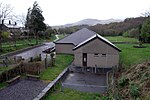Felin Hen Halt railway station
Disused railway stations in GwyneddFormer London and North Western Railway stationsPages with no open date in Infobox stationRailway stations in Great Britain closed in 1951Railway stations in Great Britain opened in 1884 ... and 2 more
Use British English from February 2020Wales railway station stubs
Felin Hen Halt railway station was a station in Glasinfryn, Gwynedd, Wales on the Bethesda branch line. The station was opened on 1 July 1884 and closed on 3 December 1951.
Excerpt from the Wikipedia article Felin Hen Halt railway station (License: CC BY-SA 3.0, Authors).Felin Hen Halt railway station
Felin Hen Road,
Geographical coordinates (GPS) Address Nearby Places Show on map
Geographical coordinates (GPS)
| Latitude | Longitude |
|---|---|
| N 53.1935 ° | E -4.1112 ° |
Address
Felin Hen Road
Felin Hen Road
LL57 4BE , Llandygai
Wales, United Kingdom
Open on Google Maps










